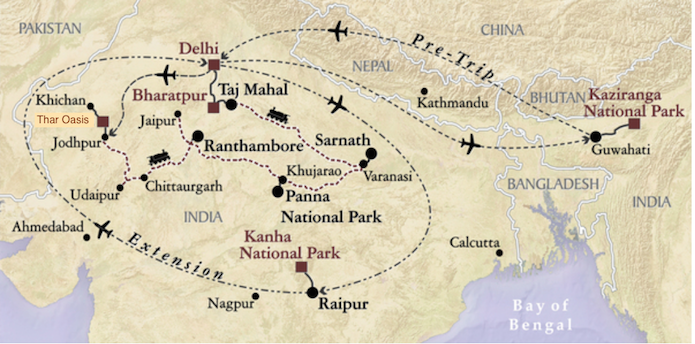
We left the train today and toured Agra (the Taj Mahal) before continuing by bus to Bharatpur
(Image courtesy of VENT)
(Click on images to enlarge)

|
We got ourselves packed and then joined the others in the dining car this
morning to do yesterday’s checklist before breakfast. Marie took a
moment to read us Tagore’s poem about the Taj Mahal (with its famous line,
“a teardrop on the cheek of Time”), which was a nice touch.
We all lingered in the dining car after breakfast, as the birding was really good. The first shouts were for Sarus Cranes! And then more Sarus Cranes. And then Painted Storks! There were also some Woolly-necked Storks, which I think I saw, but not well enough for counting a lifer. But I did get both the pale-phase and dark-phase Booted Eagles. (The Sarus Cranes are a life bird for us and the world’s tallest flying bird (6 feet or 1.8 meters).) |
 Dining/lounge car, Royal Rajasthan on Wheels (Image courtesy of Amy Sheldon) |
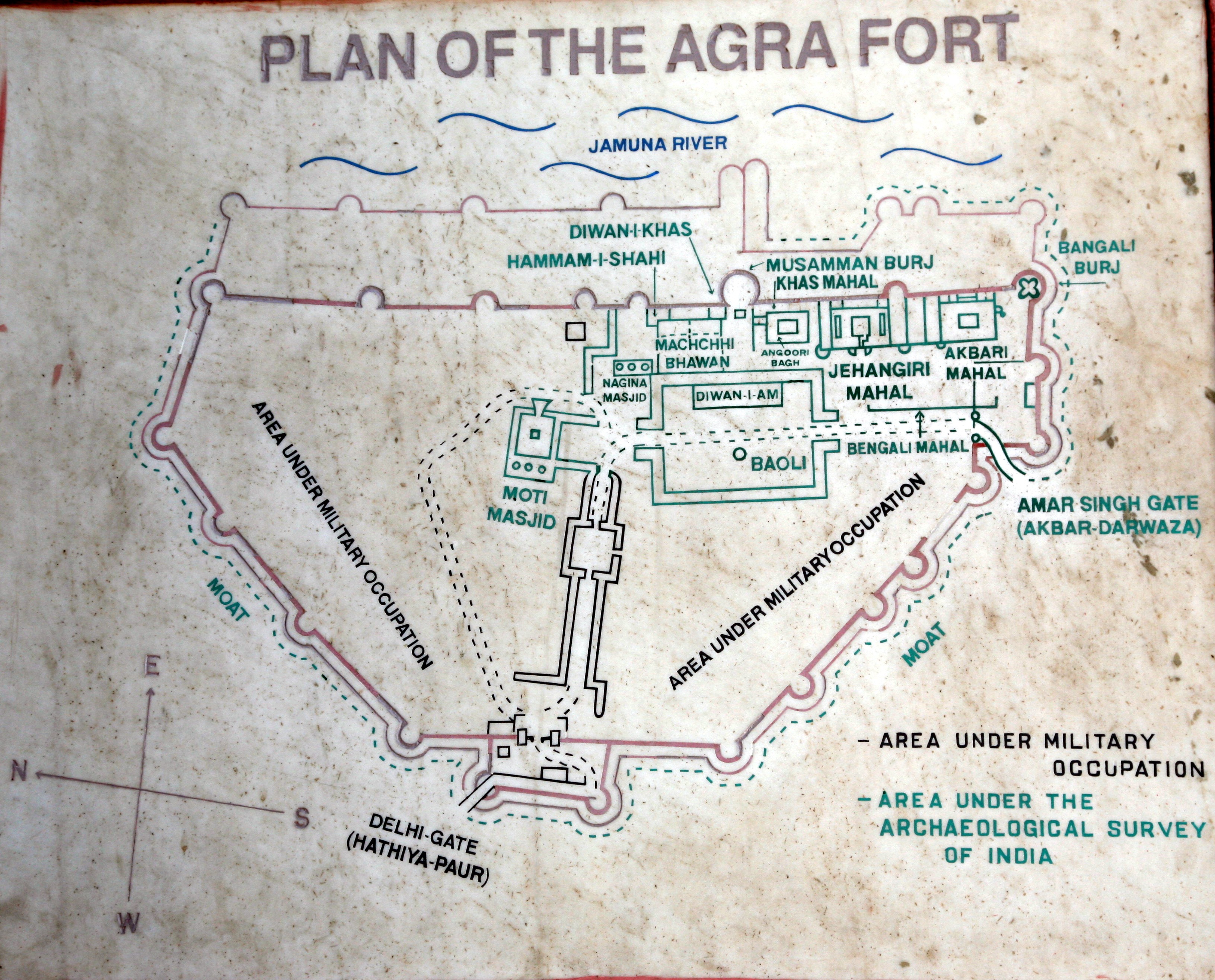
| As we approached the immense Agra Fort, Lee urged me to look out the window on his side to see the fort high above us, not realizing that I was just getting my first view of the Taj Mahal a couple of kilometers away in the other direction. But the fort was very much worth seeing. It was built late in the 16th Century by Emperor Akbar and greatly enhanced by his grandson Emperor Shah Jahan. It is really a walled city, not just a fort, and was much larger than I had envisioned (it covers 94 acres). The red sandstone it is built of is so beautiful that it would be hard to make an ugly building of it and the Mughals never attempted ugly. We had only an hour to spend seeing the fort; I would happily have spent longer. (And unfortunately some of it is used by the Indian military and is closed to the public, including what is considered to be its more beautiful gate.) |
| We were led up the long ramp to the higher levels and taken first to the Shah Jahani portions of the fort. (Shah Jahan tore down many of Akbar’s buildings and replaced them with grander ones. The British later tore down more of Akbar’s buildings and replaced them with barracks.) We passed through a red sandstone gate Shah Jahan added and then beheld his first great splurge of white marble (begun in 1628), the Diwan-i-Am (Hall of Public Audience), where the Emperor appeared to his subjects each morning. |
 Shah Jahani Gate, Agra Fort |
 Diwan-i-Am (Hall of Public Audience), Agra Fort |
|
Interior of the Shah Burj, Agra Fort |
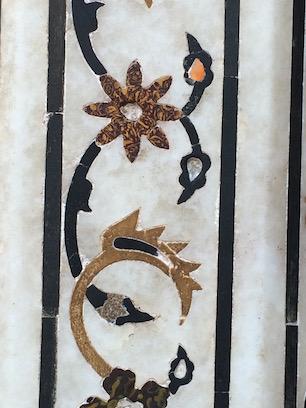 Detail of inlay, Shah Burj |
| The rooms of the Shah Burj were light and airy, high above the river, and had fountains and a small waterfall to cool them. Some of the marble was carved so thin that it was translucent. The ceilings were once colorfully painted; we saw an area where the original paint had been restored. |
|
Interior of the Shah Burj, Agra Fort |
 Restored ceiling |
|
Shah Jahan could step out onto a portico to view the Taj Mahal:
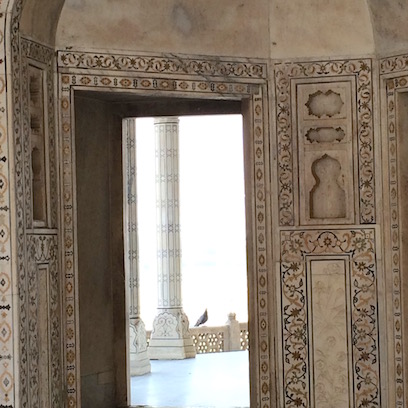 Entrance to portico of Shah Burj, Agra Fort |
 Shah Jahan’s view of the Taj Mahal |
|
When we stepped out onto that portico ourselves, we viewed the Taj further
along the river and could see that it was teeming with people. (This is both a
Saturday and part of the Holi holiday, so we had known to expect the worst.)
We then went on to a part of the fort that has been changed less since it was built by Akbar, the Jahangiri Mahal (which, despite its name, was not built by Akbar’s son Emperor Jahangir). This group of buildings dates to early in Akbar’s reign, the 1570’s, which is the same period in which the tomb of his father Emperor Humayun (which we visited in Delhi) was being built. Though quite beautiful, Akbar’s buildings seemed to me to be not quite so refined as that tomb. (I feel a great deal of empathy with Humayun, who died after tripping on his long robes while going down a stairway with his arms full of books, a fate I can readily imagine myself sharing.) |
 Leaving the Shah Burj |
Jahangiri Mahal, western facade, Agra Fort |
| Stephanie found an apparently ill Egyptian Tomb Bat under a step in one of the courtyards of the Jahangiri Mahal. We photographed it without getting too near and then found dozens more roosting in the crevices of a nearby facade. |
|
Egyptian Tomb Bat, Jahangiri Mahal |
Where the bats hang out, Jahangiri Mahal, Agra Fort |
| Then at last, we got to go to the Taj Mahal: |

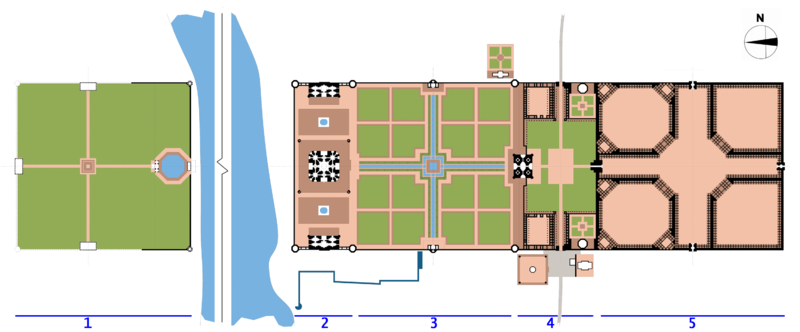
Site plan of the Taj Mahal complex
(Image courtesy of Wikimedia Commons)
|
The sectors marked on this plan correspond to:
|
|
Our bus drove us to a place where we could transfer to a small electric bus to
go the last couple of kilometers. We had to pass through a huge fair that was
a real madhouse, but eventually we reached the East Gate (via the tan
line coming down from the top in the diagram) and entered the forecourt, the
Jilaukhana. (Unfortunately, we had no chance today to see any of the
caravanserai (the Taj Ganji), which was built to help pay for the upkeep on the
rest of the complex. As you can tell from the satellite image, it has been very
heavily modified over the centuries, though I’ve seen photographs that
allow one to make out some of the original structures hidden beneath modern
encrustations. Nor could we explore the waterworks to the west of the complex
that fed the streams and fountains of the gardens with water from the Yamuna
through a system of pumps, an aqueduct (the teal squiggly line at the bottom of
the diagram), and storage tanks.)
What can one say about the Taj Mahal? I loved it! It was like having a dream come to life, all these lovely buildings that I’ve come to know from photographs suddenly looming up before me, all much larger than I had envisioned. I had feared that it would all feel like a cliché, but it didn’t. I felt only awe. Upon coming in through the East Gate, our first view was of the Great Gate, through which one passes from the Jilaukhana into the garden. We soon also noticed the South Gate, which leads to the caravanserai, much less ornate, but elegant. |
|
Great Gate, Taj Mahal |
South Gate, Taj Mahal |
| We took some time to admire the other structures in the Jilaukhana and the front of the Great Gate before passing through it. I realized only later that I had been so absorbed by the view through the Great Gate that I entirely neglected to look around as we were passing through it. |
|
Qalib kari (network tracery) on vault, Great Gate |
View of Mausoleum through Great Gate, Taj Mahal |
| Once we were through the Great Gate, we had a full view of the Mausoleum and its minarets. It was just so stunningly lovely. The thousands of people were diminished to nothing in comparison. (But my birder’s eye noted the Black Kites taking advantage of the thermals from its dome.) |

| When we had calmed down a bit and had gotten a good look at the birds on offer, we went back to savor the buildings (from the outside). It was a joy to be able to get close enough really to see the fine craftsmanship of the carving and of the marble inlays, both the flowers and the elegant calligraphy (verses from the Koran). I particularly loved the rope moldings. |
|
Detail of pishtaq (Mughal high portal), Taj Mahal |
Engaged bundled colonnettes and rope moldings |
| We circled the Mausoleum both down on the terrace and up on the platform, wondering at the lovely details of the building. Then we had time enough to explore the Meeting Hall (which is a mirror image of the Mosque). I found its red-and-white echoes of the Taj’s all-white themes to make a wonderful contrast and to be very pretty on their own merit. |
|
Assembly Hall from garden, Taj Mahal |
View of river tower from Assembly Hall, Taj Mahal |
|
Stone carving and inlay, Assembly Hall, Taj Mahal |
View of Mausoleum from Assembly Hall, Taj Mahal |
|
All in all, we were at the Taj Mahal for not quite two hours. That was
definitely not enough. We made our way back to the electric bus that took us
to the real bus. There was one more shopping stop (this time at a spice
market), but the two of us and several others resolutely remained on the bus.
Even before we were out of Agra, night had fallen. As we drove through the dark city, I noticed that many of the produce vendors have installed LED lamps on their carts to attract business. It makes a pretty scene. We had about an hour and a half of driving along a divided motorway to get to Bharatpur. It was chaotic in the usual Indian way, cars sometimes driving in the wrong direction, people crossing on foot, no apparent rules for intersections. Our nice neighbor Avinash has called my attention to this video, which will give you a feeling for how traffic works in India without rules or controls. I think you will see what I mean about its being cooperative. Nevertheless, it was likely a blessing that in the dark we couldn’t see much of what was going on. |
 Produce vendor, Agra |
 The Bagh, Bharatpur |
We arrived at our stately hotel, The Bagh, and its twelve acres of 200-year-old
gardens too late to appreciate the gardens. The hotel has only 23 rooms, set in
small buildings around the grounds. We dropped our things in the building we
share with Sally and Charlie before joining the group for dinner. At dinner,
Dion gave us the surprising news that tomorrow we will be birding by bicycle
rickshaw!
Back in our room, we concluded that we were too tired to stay up long enough for me to write my journal, so we set the alarm a bit earlier and turned out the lights. I’ll doubtless regret that tomorrow. It seemed very strange to have so much quiet after the noise of the train for the past five nights. We both slept well. |
| My birds for the day: |
| Ruddy Shelduck | Painted Stork | Great Cormorant | Great White Pelican | Dalmatian Pelican |
| Purple Heron | Eastern Cattle Egret | Black-headed Ibis | Eurasian Spoonbill | Egyptian Vulture |
| Booted Eagle | Black Kite | Sarus Crane | Black-winged Stilt | River Lapwing |
| Common Sandpiper | Rock Pigeon | Eurasian Collared Dove | Little Swift | Green Bee-eater |
| Indian Grey Hornbill | Rose-ringed Parakeet | House Crow | Common Myna |

